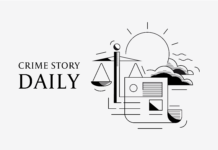This is a curated selection of highlights from Crime Story Daily this week.
On the criminal justice policy front: A piece from the New York Review of Books examines how “defunding” and “disbanding” police – radical ideas rooted in decades of prison abolitionist organizing – became the demands of the mass protest movement. As calls to defund gain unprecedented traction, NBC News focuses on what they might mean in practice, while a piece from USA Today highlights the handful of communities that have already started, diverting funding away from police budgets and into mental health resources and response teams. A piece from The Appeal emphasizes the culpability of judges in upholding mass criminalization and incarceration, while the Boston Review focuses on the role of prosecutors. A piece from the New York Times explains why federal police reform legislation stalls in Congress: law enforcement lobbies and unions, which have donated generously to members of both political parties, dictate the terms of the debate, prodding lawmakers to resist the strictest reforms. A piece from the Washington Post focuses on competing reform bills recently introduced in the House (by Democrats) and the Senate (by Republicans), explaining why both ultimately fall short. Finally, Politico Magazine highlights ten down-ballot races and initiatives that could fundamentally change the way cities and states around the country approach policing and criminal justice, from a measure to dissolve the local police department in a conservative Georgia county to Los Angeles’ upcoming prosecutor election, the “single most important DA race in the country.”
In muckraker/watchdog reporting: ProPublica goes inside the Louisiana State Penitentiary in Angola, the largest maximum-security prison in the country and home to one of its worst coronavirus outbreaks. As the virus spread, inmates described widespread illness, dysfunctional or nonexistent medical care, and rampant neglect; meanwhile, on the outside, corrections officials made rosy pronouncements about containing the virus, declaring their response a “success.” A piece from the New Republic highlights the “vast, hidden inequities of the civil legal system”: while the Constitution guarantees a universal “right to counsel” in criminal cases, Americans with civil legal needs are not afforded the same protections. For poor people, access to civil legal representation depends almost entirely on geography and luck: although 73% of low-income Americans experience at least one civil legal problem per year, 86% of them receive either minimal or no legal help to deal with it, leaving them to represent themselves in court or administrative procedures they are often woefully unprepared to navigate. And a piece from The Atlantic explores the “hidden constitutional costs of the carceral system.” Over the past 50 years, courts have repeatedly narrowed the scope of constitutional protections afforded by the Fourth, Fifth, and Sixth Amendments, which govern our criminal justice and carceral systems. Many of these decisions have resulted from cases where a broader interpretation of the law might interfere with the machinery of policing and mass incarceration. The result is that courts have “allowed the carceral system to expand unchecked while over-policed and over-incarcerated communities incur extraordinary constitutional costs.”
In complex crime storytelling: A piece from the New York Times focuses on the story of Robert Williams. In the first known case of its kind, Williams was wrongfully arrested based on a flawed match from a facial recognition algorithm. The case raises troubling questions about police use of facial recognition and highlights another, more subtle manifestation of systemic racism in law enforcement: bias in the systems used to surveil communities and identify people for prosecution. And an essay from n+1 Magazine follows the spread of COVID-19 through New York’s prison system, contrasting snippets from Gov. Andrew Cuomo’s daily coronavirus briefings with letters and emails from inmates incarcerated across the state. In his speeches, Cuomo invokes the language of social responsibility and collective care, emphasizing the need to “prioritize vulnerable populations”; but the governor’s inaction to address the outbreak in prisons and jails, and his failure to release all but a few of New York state’s thousands of prisoners, tell a different story, reflected in the increasingly frantic, panicked dispatches from inmates on the inside.
And in culture/true crime: A piece from The New Yorker highlights the art of anti-racist activism. While images of black protest undoubtedly belong to American political history, the work of Black Panther Party Minister of Culture Emory Douglas and other “angry black artists” of the twentieth century has largely been excluded from the art-history canon. The piece highlights the cultural and political significance of black protest art, calling for a broad reimagining of American art history that creates space for Douglas and his contemporaries: “art history is… a keeper of popular memory, a version of how we see our past. American art history needs to acknowledge the art made by angry black artists — as art. As American art.” And a piece from Mother Jones focuses on the problematic politics of true crime. For their mostly female listeners, true crime podcasts offer a kind of catharsis: they speak to and validate the fear that many women already carry through our everyday lives. But true crime’s escapist appeal relies on an uncritical view of law enforcement and the criminal legal system and a punitive, carceral vision of justice; in the world of true crime, the system almost always does its job, and “justice” is almost always served, usually in the form of a long prison sentence. The failings of true crime podcasts, the piece argues, do not lie in their basic premise – that women are harmed by men – because that is undoubtedly true. The problem is in their assumption that increased surveillance, policing, and incarceration are the remedies: “True crime plays into women’s fear and anger at existing in a world where they are disproportionately subjected to violence. But denuded of their political content, their radical potential, fear and anger can become advertisements for the carceral state.”

